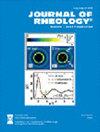聚乙烯醇溶液缔合性能的流变学研究
IF 3.2
2区 工程技术
Q2 MECHANICS
引用次数: 0
摘要
我们报告了一组五种工业聚乙烯醇(PVOH)样品的特性粘度和流动曲线测量,具有不同程度的水解,分子量和两种溶剂:水和二甲基亚砜(DMSO)的浓度。聚乙烯醇水溶液表现出明显的缔合聚合物特征,羟基羰基氢键似乎主导了聚合物链的缔合。我们提出了一个“粘团”模型,适用于任何具有许多粘团的缔合聚合物溶液,该模型预测了纠缠状态下特定粘度和链弛豫时间的浓度依赖性。当PVOH聚合物溶解在DMSO(一种强氢键受体)中时,所有相关程度的水解都完全阻止了链链结合。链的比粘度和弛豫时间恢复了DMSO中非缔合柔性聚合物的预期浓度依赖性。文献数据显示,在水中100%水解的PVOH也具有同样的浓度依赖性,因为在链间结合中占主导地位的乙酸含量为零。比较相同浓度的纠缠水溶液和DMSO溶液,可以通过实验测量由于关联引起的时间延迟,如水溶液和DMSO溶液的终端弛豫时间之比。这种时间延迟的浓度依赖性也被本工作中引入的简单粘团模型所捕获。本文章由计算机程序翻译,如有差异,请以英文原文为准。
Rheological investigation on the associative properties of poly(vinyl alcohol) solutions
We report intrinsic viscosity and flow curve measurements on a set of five industrial poly(vinyl alcohol) (PVOH) samples, with varying degree of hydrolysis, molecular weight, and concentration in two solvents: water and dimethyl sulfoxide (DMSO). Aqueous poly(vinyl alcohol) solutions exhibit clear features of associative polymers, and the hydroxyl-carbonyl hydrogen bonds seem to dominate polymer chain associations. We propose a “sticky-blob” model, applicable to any associating polymer solution with many stickers inside each correlation blob, which predicts the concentration dependence of the specific viscosity and the chain relaxation time in the entanglement regime. When PVOH polymers are dissolved in DMSO, a strong hydrogen bond acceptor, chain-chain associations are fully prevented for all relevant degrees of hydrolysis. The specific viscosity and the relaxation time of the chain recover the expected concentration dependences for nonassociating flexible polymers in DMSO. The same concentration dependences are exhibited by literature data on 100% hydrolyzed PVOH in water, as the acetate content, dominating interchain associations, is zero. Comparing entangled aqueous and DMSO solutions at the same concentration enables the experimental measure of the time delay due to associations as the ratio between the terminal relaxation time of solutions in water and DMSO. The concentration dependence of such a time delay was also captured by the simple sticky-blob model introduced in this work.
求助全文
通过发布文献求助,成功后即可免费获取论文全文。
去求助
来源期刊

Journal of Rheology
物理-力学
CiteScore
6.60
自引率
12.10%
发文量
100
审稿时长
1 months
期刊介绍:
The Journal of Rheology, formerly the Transactions of The Society of Rheology, is published six times per year by The Society of Rheology, a member society of the American Institute of Physics, through AIP Publishing. It provides in-depth interdisciplinary coverage of theoretical and experimental issues drawn from industry and academia. The Journal of Rheology is published for professionals and students in chemistry, physics, engineering, material science, and mathematics.
 求助内容:
求助内容: 应助结果提醒方式:
应助结果提醒方式:


